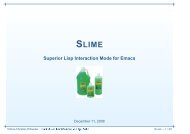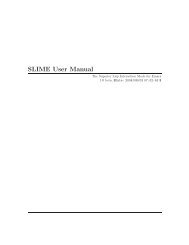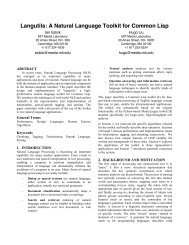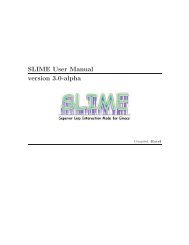The CMUCL Motif Toolkit - Common Lisp.net
The CMUCL Motif Toolkit - Common Lisp.net
The CMUCL Motif Toolkit - Common Lisp.net
- No tags were found...
You also want an ePaper? Increase the reach of your titles
YUMPU automatically turns print PDFs into web optimized ePapers that Google loves.
*CONVENIENCE-AUTO-MANAGE* Controls whether convenience functions automaticallymanage the widgets they create. <strong>The</strong> default is NIL.5 CallbacksCallbacks are registered with the ADD-CALLBACK function. Unlike <strong>Motif</strong> in C,an arbitrary number of client-data items can be registered with the callback.Callback functions should be defined as:(defun callback-handler (widget call-data \&rest client-data) ... )<strong>The</strong> passed widget is that in which the callback has occurred, and the calldatais a structure which provides more detailed information on the callback.Client-data is some number of arguments which have been registered with thecallback handler. <strong>The</strong> slots of the call-data structure can be derived from the Cstructure name using the standard name conversion rules. For example, thecall-data structure for button presses has the following slot (aside from thestandard ones): click-count.To access the X event which generated the callback, use the following:(defun handler (widget call-data \&rest client-data)(with-callback-event (event call-data);; Use event structure here))Since callback procedures are processed synchronously, the <strong>Motif</strong> serverwill remain blocked to event handling until the callback finishes. This can bepotentially troublesome, but there are two ways of dealing with this problem.<strong>The</strong> first alternative is the function UPDATE-DISPLAY. Invoking this functionduring your callback function will force the server to process any pending redrawevents before continuing. <strong>The</strong> other (slightly more general) method is toregister deferred actions with the callback handling mechanism. Deferred actionswill be invoked after the server is released to process other events and thecallback is officially terminated. Deferred actions are not invoked if the currentapplication was destroyed as a result of the callback, since any requests to theserver would refer to an application context which was no longer valid. <strong>The</strong>syntax for their usage is:(with-callback-deferred-actions )You may register only one set of deferred actions within the body of anyparticular callback procedure, as well as within event handlers and action procedures.Registering a second (or more) set of deferred actions will overwriteall previous ones.When using deferred action procedures, care must be taken to avoid referencinginvalid data. Some information available within callbacks is only validwithin the body of that callback and is discarded after the callback terminates.For instance, events can only be retrieved from the call-data structure withinthe callback procedure. Thus the code4















